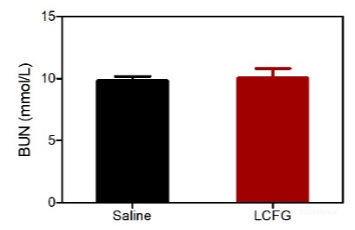Urea (BUN) Colorimetric Assay Kit (Urease Method)
SKU: E-BC-K183-M-500
Urea (BUN) Colorimetric Assay Kit (Urease Method)
| SKU # | E-BC-K183-M |
| Detection Instrument | Microplate reader (565-595 nm, optimum wavelength: 580 nm) |
| Detection method | Colorimetric method |
Product Details
Properties
| Synonyms | BUN |
| Sample type | Serum, plasma, urine, saliva, milk |
| Sensitivity | 0.09 mmol/L |
| Detection range | 0.28-35 mmol/L |
| Detection method | Colorimetric method |
| Assay type | Quantitative |
| Assay time | 30 min |
| Precision | Average inter-assay CV: 4.300% | Average intra-assay CV: 2.800% |
| Other instruments required | Micropipettor, Centrifuge, Incubator, Vortex mixer |
| Other reagents required | Normal saline (0.9% NaCl), PBS (0.01 M, pH 7.4) |
| Storage | 2-8℃ |
| Valid period | 12 months |
Images
X Zhang et al investigate the usage of H2O2 and O2 for cooperative chemodynamic / starvation cancer therapy. Urea (BUN) level in mouse blood was determined using urea colorimetric assay kit (E-BC-K183-M).

No significant change of urea was observed, the LCFG nanoparticles did not include nephrotoxicity.
Dilution of Sample
It is recommended to take 2~3 samples with expected large difference to do pre-experiment before formal experiment and dilute the sample according to the result of the pre-experiment and the detection range (0.28-35 mmol/L).
The recommended dilution factor for different samples is as follows (for reference only):
| Sample type | Dilution factor |
| Human serum | 1 |
| Rat plasma | 1 |
| Human saliva | 1 |
| Human urine | 50-70 |
Note: The diluent is normal saline (0.9% NaCl) or PBS (0.01 M, pH 7.4).
Detection Principle
Urea can be decomposed into ammonia ion and carbon dioxide by urease. Ammonia ion can react with amphyl and form a green substance in alkaline medium, and the production of the green substance is proportional to the urea content which can be calculated with the colorimetric assay at 580 nm.
Kit Components & Storage
| Item | Component | Size 2(96 T) | Storage |
| Reagent 1 | 100 mmol/L Urea Standard | 2 mL × 1 vial | 2-8°C, 12 months |
| Reagent 2 | Enzyme Stock Solution | 0.05 mL × 1 vial | 2-8°C, 12 months, shading light |
| Reagent 3 | Enzyme Diluent | 15 mL × 1 vial | 2-8°C, 12 months |
| Reagent 4 | Chromogenic Agent | 15 mL × 1 vial | 2-8°C, 12 months, shading light |
| Reagent 5 | Alkaline NaClO | 15 mL × 1 vial | 2-8°C, 12 months, shading light |
| Microplate | 96 wells | No requirement | |
| Plate Sealer | 2 pieces |
Note: The reagents must be stored strictly according to the preservation conditions in the above table. The reagents in different kits cannot be mixed with each other. For a small volume of reagents, please centrifuge before use, so as not to obtain sufficient amount of reagents.
Technical Data:
Parameter:
Intra-assay Precision
Three human serum samples were assayed in replicates of 20 to determine precision within an assay. (CV = Coefficient of Variation)
| Parameters | Sample 1 | Sample 2 | Sample 3 |
| Mean (mmol/L) | 1.50 | 12.70 | 26.00 |
| %CV | 3.3 | 2.7 | 2.4 |
Inter-assay Precision
Three human serum samples were assayed 20 times in duplicate by three operators to determine precision between assays.
| Parameters | Sample 1 | Sample 2 | Sample 3 |
| Mean (mmol/L) | 1.50 | 12.70 | 26.00 |
| %CV | 4.1 | 4.5 | 4.3 |
Recovery
Take three samples of high concentration, middle concentration and low concentration to test the samples of each concentration for 6 times parallelly to get the average recovery rate of 104%.
| Standard 1 | Standard 2 | Standard 3 | |
| Expected Conc. (mmol/L) | 8.5 | 18 | 29.5 |
| Observed Conc. (mmol/L) | 8.8 | 19.3 | 30.1 |
| Recovery rate (%) | 103 | 107 | 102 |
Sensitivity
The analytical sensitivity of the assay is 0.09 mmol/L. This was determined by adding two standard deviations to the mean O.D. obtained when the zero standard was assayed 20 times, and calculating the corresponding concentration.
Standard Curve
As the OD value of the standard curve may vary according to the conditions of the actual assay performance (e.g. operator, pipetting technique or temperature effects), so the standard curve and data are provided as below for reference only.
| Concentration (mmol/L) | 0 | 5 | 10 | 15 | 20 | 25 | 30 | 35 |
| Average OD | 0.045 | 0.129 | 0.223 | 0.309 | 0.393 | 0.471 | 0.555 | 0.644 |
| Absoluted OD | 0 | 0.084 | 0.179 | 0.264 | 0.348 | 0.426 | 0.510 | 0.599 |



